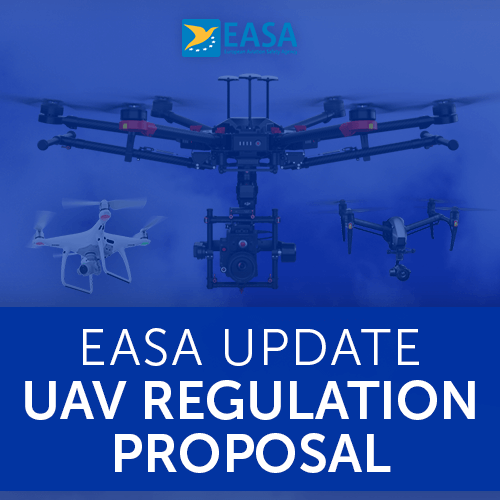
Training & Regulations
Published on 16 Feb 2018
James Willoughby
EASA Update UAV Regulation Proposal
Heliguy discuss the proposed EASA regulations that have just been announced that will affect the UK once released. ... Read More
Heliguy-EASA_Update_UAV_Regulation_Proposal-Blog_Header-optimized.png EASA Update UAV Regulation Proposal EASA (The European Aviation Safety Agency) have just published the latest stage in their proposal for changes to the regulation of the use of UAVs in Europe. This latest stage is the ‘Proposal to Commission’ in the EASA rulemaking process and follows the feedback on the proposal in May of 2017. The document details suggestions of new and revised regulations that could become mandatory following the final decision in the first quarter of 2019. Keep reading to find out the potential new regulations from EASA and how it could affect your drone and the UAV industry. Heliguy_Blog-EASA_rulemaking_process_milestones_Feb_2018-optimized.png EASA Rulemaking Deadlines
Proposed Regulations
The proposed changes to the European and UK drone regulations relate to both the aircraft and its operation. A new aircraft category system has been suggested for aircraft based on their weight, speed and a few other factors. The below table can be used as a guide to the different categories each aircraft will be part of: __Heliguy_Blog-Drone_Types_Req-v2-optimized.png__As you can see from the above, categories range from C0 to C4, starting with toy drones and going up to enterprise aircraft in C3 and model aircraft in C4. Each category has a set of regulations it will have to adhere to which will largely be the responsibility of the manufacturers and national regulators. The key areas where potential new regulations can be seen are new requirements for the C1 to C3 categories. The category features all DJI drones from the Spark up to the Matrice 200 Series. For these categories, a unique serial number and fire-retardant placard are a suggested requirement. These features are likely suggested for the identification of an aircraft following an incident. In addition to these suggestions, E-identification and geoawareness, the new name for geofencing, will also be required for these categories. National registration for the aircraft in these categories is also a suggested requirement. The suggestions of geoawareness and aircraft registration are in line with the proposed UK regulation changes due to be announced in the second quarter of 2018. Another suggestion for categories C2 and C3 is the potential requirement for data link protection and lighting requirements different to manned aviation. This is likely to be in order to assist with the easy distinguish between manned and unmanned aerial vehicles. As part of the new regulation, the sale of all new drones will have to include an EASA Safety Leaflet and product information. This may include further information on the specific countries regulation, for example, the inclusion of CAA document. Rather than being based on weight, racing drones will be included in category C3. This is due to the speed and powerful capability of these aircraft and likely the damage the could cause if there was an incident. To date, there’s been no mention of retrospective alterations to older aircraft and as such, we’re currently unsure of what the process is likely to be. Copy-of-DSC02499.jpg DJI Inspire 2 in Flight
Reasons Behind the Update
In their latest proposal, EASA explains the reasoning behind the suggested changes to the European drone regulation. The key reason given for the suggested regulation changes is related to safety, due to the rapid expansion of the drone industry over recent year. Concerns are noted over a potential air collision with a manned or unmanned vehicle and/or ground collision with a person or building. The number of reported incidents or near-incidents has seen an increase in the popularity of drones. Due to these factors, a change to EU regulation is suggested by EASA to reduce the risk of any incident. training_farn_room-700x479.jpg PfCO Group Farnborough
Summary
The amendments to the EASA regulations for drone use will likely have an interesting outcome for the drone industry. Aspects of the proposals will bring European countries in line with countries like the United States by the way of drone registration. However, this was likely going to be included in the UK's Drone Bill announced at the end of 2017. With all aspects of the suggested changes, it's clear that safety is the key leading factor with accountability close behind. Being able to identify a drone's pilot electronically and physically should lead to more responsible flight with the fear of legal repercussions. With the next stage due in the final quarter of 2018 and implementation in 2019, it will remain an interesting time for the drone industry until the changes are made official.
To discuss emergency drone procedures and incident reporting, or any DJI or Freefly product, please give one of our team a call on 0191 296 1024 or email us at info@heliguy.com.
Keep checking back to Heliguy’s Insider Blog for more announcements, insights into drones and, of course, the latest news from the drone industry.
